Panama Canal

Yacht Scratch
I actually went through twice, once a board Scratch and again on Jackal. Scratch can be described as an intercontinental ballistic cruising boat. This is a small subset of yachts for the impatient cruiser. Think of an open 60, like Kingfisher, Dame Mad Ellen Wench's famous boat. It was fast. It was also set up so one person can handle it. Every now and again people build cruisers using some of the same ideas. Big balanced rudders with autopilots. Big sail, but all carefully set up to allow one or two (fairly gung ho) people to operate. Scratch is one of these, sixty foot an the ARC 2005 tried to refuse to handicap it, its owner mostly single hands. The rig is big but simple. The hull light. This is my sort of dream boat. Pitty I didn't get to sail it. Many of these have water ballast. Tanks that you pump sea water into on either side of the boat to add weight to windward. Hunter HC50 is another type, i want one (apart from they're made by hunter). But light crew is not allowed by the Panama Canal, you must have Skipper, 4 line handlers and a Pilot. I was extra help - he didn't really want all that beer he had anyway....
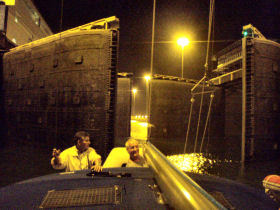
Gatun gates closing behind Jackal
Anyway where was I oh yes the Canal. Well both transits started at night, about 9:00pm. Which is a shame because Gatun Locks are right on the edge of the Caribbean. The front of one lock is the rear of the next. 3 giant steps up to Gatun Lake. If your sharing the lock with a ship then you are put in after it , resulting in a fabulous view back down the Caribbean. At night this is ruined. On the other side your at the back of the locks again so you can't see over the gate and down. Also they're split into 2 sections. So you can't see the Pacific from the Top.
On both occasions we stopped over night in Gatun Lake just inside the locks. Scratch anchored but we were tied to a bouy. In a very odd way.
We were told the Pilot would be there at 6:00am to take us through the rest of the canal. Mind you that's what they told us on Scratch too, and he got there at 7:30, the night pilot said it would probably be actually 7:00

Lummy!
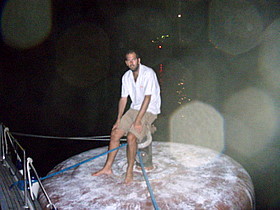
Me on the Buoy
We were woken by the pilot actually tuning up at 6:00am! Fortunately pilot boats are noisy and have hooters. Though not like these hooters left, found on a mannequin in Panama City's bus station.
Off we went through the banana boat channel. A shallower narrower channel through Gatun Lake. Before you think "canal" in the English ditch crawling way, remember Gatun Lake is half the canal, at the time of construction the largest body of man made water in the world. Its huge. Dead trees sprout out of it from the old primary forest.
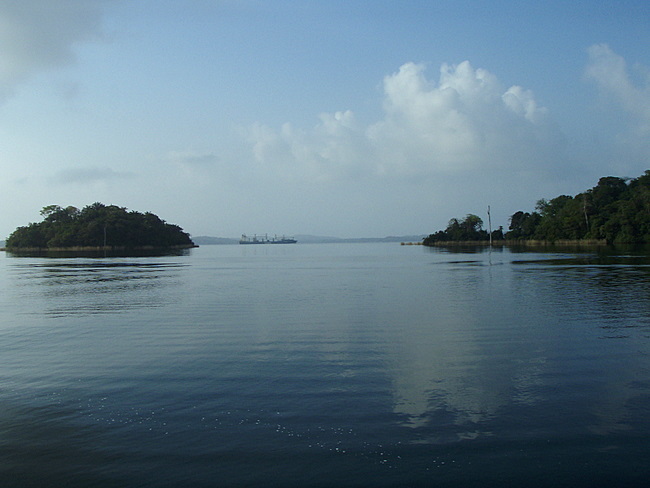
Gatun Lake is bigger than Elvis after all the burgers.
After the lake is the Narrow cut through the continent. This is in the process of being widened at present to accommodate bigger ships, bigger locks are being planned too. They'll not be ready any time soon, so the canal will make it to 100 years old before its upgrade, 100years before a major upgrade is hellish impressive. Actually the French started a Canal, before the current one, but it didn't get far the remains are virtually indistinguishable from Colon harbour.
The Cut was busy, on both trips, its narrow, the banks are cluttered with diggers, scoops, barges and dredgers. Tugs are ferrying the spoil barges around and people keep pointing panamax (Ships built deliberately to the maximum size of the canal's locks) ships at you.
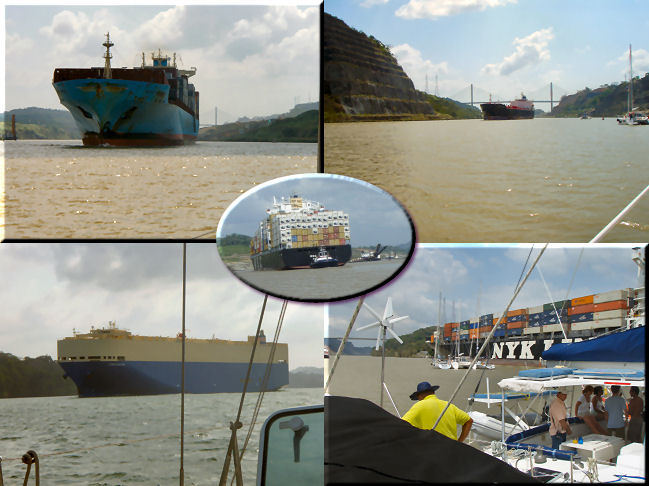
Lots of ships about,
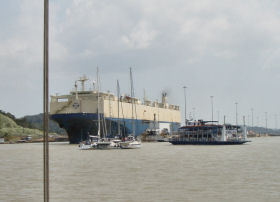 At the largest cutting of the canal is a new bridge. Just beyond it is the first lock down towards the Pacific. Pedro Miguel Locks. There are twin locks throughout the canal, so ships can go up and down simultaneously. They can be both used in the same direction the bottom right image above was taken seconds before the one right. The Car carrier exited the southern lock Atlantic bound, the container ship the northern, also coming up. We were busy rafting up three yacht (my opinion of the seamanship and manners of the middle one is unpublishable). There were 3 other rafts of yachts preping to go down too. Two boat loads of tourists over took us as all this was going on and a tug rushed by. The shot left shows a tourist barge, nosing round a raft of yachts towards the southern lock as the car carrier steams out. scary stuff.
At the largest cutting of the canal is a new bridge. Just beyond it is the first lock down towards the Pacific. Pedro Miguel Locks. There are twin locks throughout the canal, so ships can go up and down simultaneously. They can be both used in the same direction the bottom right image above was taken seconds before the one right. The Car carrier exited the southern lock Atlantic bound, the container ship the northern, also coming up. We were busy rafting up three yacht (my opinion of the seamanship and manners of the middle one is unpublishable). There were 3 other rafts of yachts preping to go down too. Two boat loads of tourists over took us as all this was going on and a tug rushed by. The shot left shows a tourist barge, nosing round a raft of yachts towards the southern lock as the car carrier steams out. scary stuff.
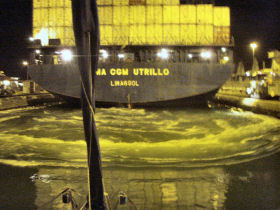 The down locks are relatively straight forward, yachts or yacht rafts lock centre chamber, with 4 lines running out to hold them in place. All you do is ease out slack as the water goes down. Going up is a different story. The water runs in through culverts in the base of the lock chambers. This kicks up turbulence. White water rafting for yachts. If your sharing a lock with a ship its moored to small railway engines at all corners (sometimes 2 to a corner). These run on rails up the lock. Despite this they run their main screws to push them forward. This is like sloshing water in a giant bath, and were talking one big bath.
The down locks are relatively straight forward, yachts or yacht rafts lock centre chamber, with 4 lines running out to hold them in place. All you do is ease out slack as the water goes down. Going up is a different story. The water runs in through culverts in the base of the lock chambers. This kicks up turbulence. White water rafting for yachts. If your sharing a lock with a ship its moored to small railway engines at all corners (sometimes 2 to a corner). These run on rails up the lock. Despite this they run their main screws to push them forward. This is like sloshing water in a giant bath, and were talking one big bath.
I can't stress the size of the locks, the ship in the picture above right should give and indication. The one below gives a scale on the whole edifice. I had to use the panorama and image stitch functions of my camera.
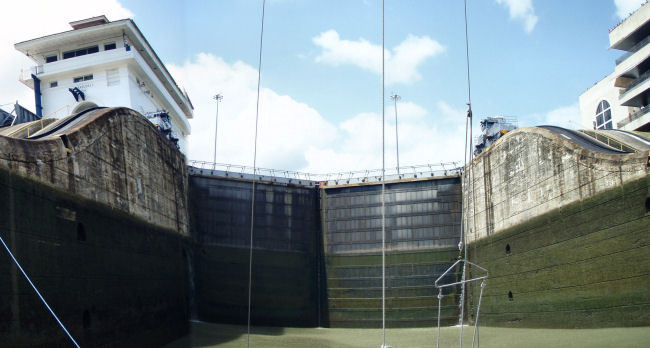 ;
;
Mirraflores Locks
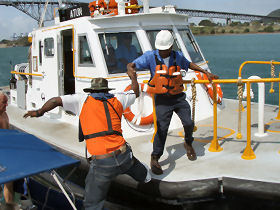
Our pilot departs
After exiting the final set of locks at Mirraflores, you're into the pacific. The really entrance to the pacific is the bridge of the Americas. This, until the new bridge was built since last time I came through in 99, this was the only connection between North and South America, bar a swing bridge at Gatun, which given the traffic on the canal can't be terribly useful.
Panama is the crossroads of the world, the only connection between North and South America, and the Atlantic an Pacific oceans.
The Pacific comes as a culture shock, the water is much colder than the balmy Caribbean, thanks to Humbolt and his invention the current (still used in fruit cake to this day). The Humboldt current flows up the east of South America, bringing cold Antarctic water to the tropics. In addition to the cold water, the tide here is springs and 5 meters! We've been used to small tide in the Canaries and virtually undetectable tides in the Caribbean. The dinghy dock today was aground, we decided that the dinghy might get under it before it floated, crushing the dinghy so we found another spot,. My prediction came true, this is exactly what it did to a large fiberglass boat, forced its outboard under too. We've been sailing in the trades since the Canaries too. Wind varies, but there's nearly always some and it from eastish. Here in Panama we've got the inconvenient Humboldt current to look forward to, and the inter tropical convergence zone. Better know as the doldrums to look forward to. The phrase in the doldrums is referring to the depressing and frustrating windless belt around the equator. Next stop the Galapagos, hopefully the engine trouble we experienced last time (21 days to get 900 odd miles) will not repeat. And yes its good to be back in the Pacific.
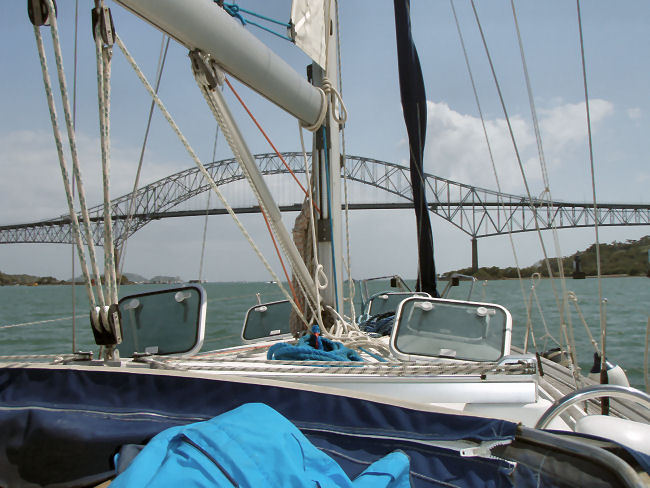
Bridge of the Americas
9° 67.7' N, -79° 42.3' W